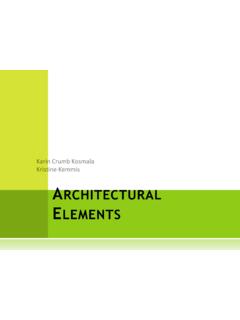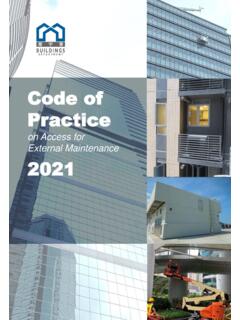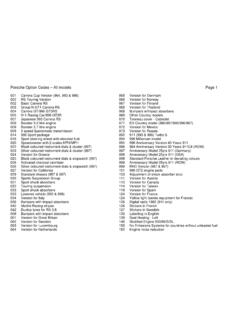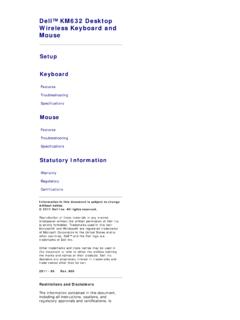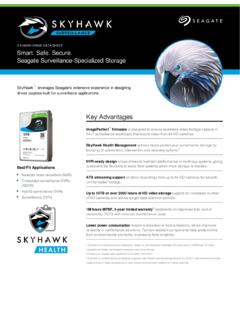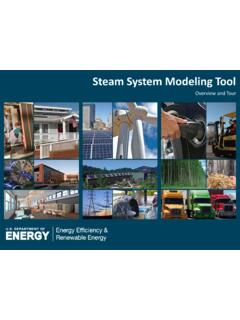Transcription of Intro to VRAY for SketchUp
1 Intro to VRAY for SketchUp By Eric Sargeant, Online Learning Content Producer | DRAFT June 2019. Purpose & Contents Intro to VRAY for SketchUp Purpose This guide is a high-level overview of the core features for getting started with V-Ray for SketchUp 2019. The powerful of VRAY is in its customizability and the level of detail it offers its users in creating incredibly realistic on the flip side, for new users, it can be overwhelming knowing where to start or what to look for. The primary goal of this guide is to focus on the minimum tools and settings to get both good and quick results. This guide condenses the essential concepts into 6 easy to follow sections which provide just enough info to get you up and running. Other than the first section, Toolbars & interface', the other sections are presented in a logical fashion but are not required to be followed in order and therefore can be skipped or skimmed as desired. If you have questions regarding the topics covered or the source material presented within this guide, please post to the SketchUp Community Forum page specific to this guide here: xxx or contact the author at: Contents 1.
2 Toolbars & Interface 2. Materials 3. Objects 4. Environment 5. Lighting 6. Output Contents Reference Model Original The model used for this demo is the Federmann House, designed by architect Oscar Niemeyer. Get it from 3D Warehouse: 857b-44fae0f65ae8/Modern-House Final VRAY-Ready Model Edited VRAY model with settings applied can be downloaded here: Casa% *Note trees are from Laubwerk (free extension, paid library) found here: Final render combining elements of the six (6) core topics covered in this guide. Contents 5 Minute Quick-Start Render Exercise 5 minute quick start render demo: Let's ease into things with a quick confidence-building exercise to get you started. If you've used VRAY before, feel free to skip this step. Step 1. Download this car, or any other model from the 3D. Warehouse with the search keyword VRAY Ready'. 4a44-8046-f5bba04a01f3/CAR-REANGE-ROVER- VRAY- READY. Step 2. Draw a rectangle on the ground to give the car something to sit on and something for its shadows to cast onto.
3 Step 3. Click the Render button (teapot icon) on your VRAY for SketchUp tool palette. That's it! Pretty easy huh? FYI - searching for VRAY Ready' or Render Ready' models should produce results with VRAY materials and settings already applied, potentially making it a larger file size, but speeding up the render process significantly by freeing you up to focus on other settings. Quick Start Exercise 1. VRAY Toolbars &. Interface Intro to VRAY for SketchUp Toolbars VRAY Render Toolbar This is the main toolbar that provides access to the Asset Editor (settings) panel as well as your render buttons. VRAY Objects Toolbar These are objects you can add to your model. VRAY Lights Toolbar These are lights you can add to your model. *You can find the VRAY toolbars in the same location as others: View/Tool Palettes/.. 1. VRAY Toolbars & Interface Intro to VRAY for SketchUp Toolbars - Tools Asset editor (aka settings). Render Interactive (aka real time (RT)) render Viewport render Viewport render region Frame buffer Batch render Cloud batch render Lock camera orientation Infinite plane Export proxy Import proxy VRAY fur Mesh clipper Rectangel light Sphere light Spot light Omni light IES light Dome light Convert to mesh light *Faded items will not be discussed in this high level overview 1.
4 VRAY Toolbars & Interface Asset editor (aka settings). Geometries (Objects). Materials Lights Render Textures Render Settings Render Frame Elements (Shown) Buffer Expand Expand *Faded items will not be discussed in this high level overview, typ. 1. VRAY Toolbars & Interface Asset editor (aka settings). Render Settings (Expanded). Expand window to see more settings *We'll come back to this panel at the end in section 6, Output'. 1. VRAY Toolbars & Interface Render (static/still image) Frame buffer Interactive (aka real time (RT) render) Works the same for both static and interactive (real time) renders. Render shows up as separate window that floats above SketchUp and can be moved to second monitor (if available) to keep SketchUp window clear. Frame buffer Closing the frame buffer and re-opening it brings back the previous rendered image. Image remains until new render has started. *Closing the frame buffer does not mean that a render is stopped. Make sure to press Stop' first before closing.
5 Render Channels (ie Save rendering (see Stop render alpha, depth, MatID, Section 6, Output for ) more info). Additional editing Progress indicator settings 1. VRAY Toolbars & Interface Viewport render This is a newish feature, similar to Interactive render, only it Viewport render displays in the SketchUp window itself vs the floating Frame Buffer. Panning or zooming, as well as making changes to the model will update the render in real time. 1. VRAY Toolbars & Interface Viewport render region You can select just a part of the viewport to render. This is a nice option as it doesn't cover the entire model, allowing you to work and render at the same time and see the result of your changes. Viewport render region Rendering smaller regions also uses less computing power and runs faster than larger renders. You can toggle back and forth between viewport and Frame Buffer rendering during render by clicking on either. 1. VRAY Toolbars & Interface 2. Materials Materials Overview Materials library Materials preview Materials in model Materials settings Expand left window for default materials library Expand right window for material editing options Materials Materials are a good place to start since they have the single biggest impact on making a model go from looking flat and static, to rich and realistic.
6 VRAY materials include settings additional settings that aren't available in SketchUp alone. For example, diffuse (base texture), bump (illusion of 3D depth), displacement (actual surface depth), reflection and refraction (deflected light passing through opaque objects), emission (or emmissive meaning emits light), etc. When working together, these maps and settings combine to form any number of realistic real-world materials. VRAY includes a great default library of materials to get started with. You can also import materials downloaded from elsewhere, edit SketchUp materials, or create materials from scratch. 2. Materials Applying Materials Materials library Materials preview Materials in model Materials settings (advanced settings for making changes). Selecting default materials To apply a material, first find the material you want from the specific category in the materials library (left). Then drag and drop it into the model materials area (center). 2. Materials Applying Materials Applying materials Then either right click the material and apply it to an entire layer (say window glazing if all your glass has been assigned its own layer) or to selection in the model.
7 Alternatively, if using selection method, first select the group(s), component(s), or geometry in SketchUp that you want your material to be applied to. Then choose apply to selection' in VRAY. The nice thing about this method is that if you have a group or component with nested geometry, it will apply the material to everything within that group or component at once. 2. Materials Intro to VRAY for SketchUp Scaling / Resizing Materials Default scale Materials with a texture, or diffuse map, will also have a scale associated with it. These are in metric units by default (Chaos Group is from Bulgaria by the way) and therefore come in smaller than reality. Edited (correct) scale Just edit the material (like any other material) in SketchUp , setting the right size for the material. All associated maps (bump, etc) will update automatically. 2. Materials Intro to VRAY for SketchUp Material Render Preview Render test It's a good idea to do a quick interactive render to see that the material has been applied and renders correctly before spending too much time applying a lot of materials.
8 Material detail The default concrete texture has maps applied already and as you can see react differently to different light / shadow settings. 2. Materials Materials Exercise Styrofoam_A01_12cm Waves_A_02_200cm CarPaint_Flakes_WineRed Grass_C_200cm Aluminum_Blurry Glass_Crystal18. Exercise Download or make a simple model. Copy it and apply a variety of materials to each. *Be sure to re-scale any materials that have a texture (diffuse map) associated with them. For this example, the Ocean Waves and Grass materials were re-scaled. 2. Materials 3. Objects Objects - Infinite Plane Infinite plane Without Infinite Plane (Default). By defualt, VRAY does not render a ground plane. If render saved as /. PNG, background is transparent. You can add a ground in yourself using SketchUp geometry or use the Infinite Plane in the Objects toolbar. Infinite Plane with Material Added With Infinite Plane Example: Waves material was added to The infinite plane extends to the horizon and receives shadows.
9 By create fast and realistic infinite ocean default, it is white but you can add any color or material to it to extend scene. your model's ground plane. 3. Objects Objects - Proxies Medium poly tree from 3D Warehouse Export Proxy VRAY Proxy (low poly replacement for tree). What are proxy objects? Proxies are placeholders. They save the geometry and textures to a combined external file and replace them with a simplified version of your object. Then, at render time, the original file, etc is keeping your model light and nimble at all times. Proxies are used more often for things like vegetation that tend to have high polygon counts but can be created for anything in your model that you either a: have really high poly counts, or b: you have a lot of them placed around your model. Proxy File Creating proxies Proxy objects are saved to First select the object you want to turn into a proxy, then click the Export Proxy' icon your hard drive with a .vrmesh' in the Objects toolbar and you're prompted with some settings to refine, including extension.
10 Destination for the .vrmesh file to be stored, the number of faces in your placeholder . and whether or not you want to replace the current selected object in your model or not. 3. Objects Objects - Proxies Geometries Object (Geometries) Window The proxies in your model are shown in the Geometries tab. If you select a proxy, it will show to the right it's file path to where it is saved on your drive. *Keep in mind that this path has to stay the same for it to load properly. If you move or rename your proxy file or location folder, you will have to re-path it here for it to render properly. 3. Objects Objects - Proxies - Laubwerk Laubwerk library Some companies, Like Laubwerk, have identified the need to simplify and expidite the proxy creation, selection and import process and therefore have developed a plugin that provides quick access to purchased proxy trees. Laubwerk variety settings Each plant is actually 36 plants as they have 3 varieties, 3 ages (sizes), and 4 seasons to choose from.
